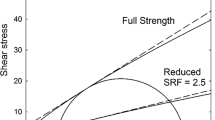Abstract
There is a need for a unified strength criterion, which is a variable suitable for describing the different strength properties of different types of geomaterials. In this study, a unified nonlinear strength (UNS) criterion is proposed based on the Lade-Duncan criterion for the sake of versatility to capture the complex strength behaviors of geomaterials under three-dimensional (3D) stress paths. The strength curves in this theory are a series of continuous and smooth conical loci that covers wide ranges of the meridian and octahedral planes to describe the nonlinear strength behaviors of soils. The strength curves are located between von Mises and Lade-Duncan strength curves in the deviatoric plane in the principal stress space. Verifications between the proposed criterion and experimental data from triaxial tests found in the literature show that this new criterion is able to reasonably reflect the three-dimensional (3D) strength properties and strength nonlinearity of a variety of geomaterials.









Similar content being viewed by others
References
Chen WF (1998) Strength theory: applications. Developments and prospects for 21st century. Concrete plasticity: past, present and future, Yu M H, Fan S C. Science Press. Beijing, New York, pp 7–48
Gupta AK (2000) Constitutive modeling of rockfill materials. Indian Institute of Technology, Delhi, India
Hoek E, Brown E (1980) Empirical strength criterion for rock masses. J Geotech Eng Div 106(9):1013–1035
Lade PV (1977) Elasto-plastic stress-strain theory for cohesionless soil with curved yield surface. Int J Solids Struct 13(11):1019–1035
Lade PV, Duncan JM (1975) Elastoplastic stress-strain theory for cohesionless soil. J Geotech Eng Div 101(GT10):1037–1053
Li L, Aubertin M (2005) Formulation and application of a general inelastic locus for geomaterials with variable porosity. Can Geotech J 3:601–623
Liu MD, Carter JP (2003) General strength criterion for geomaterials. Int J Geomech 3(2):253–259
Liu MC, Gao YF, Huang XM (2005) Study on elasto-plastic constitutive model of rockfills with nonlinear strength characteristics. Chinese Journal of Geotechnical Engineering 27(3):294–298 (in Chinese)
Liu M, Gao Y, Liu H (2012) A nonlinear Drucker–Prager and Matsuoka–Nakai unified failure criterion for geomaterials with separated stress invariants. Int J Rock Mech Min Sci 50:1–10
Liu XR, Tu YL, Wang P, Zhong ZL, Tang WL, Du LB (2017) Particle breakage of soil-rock aggregate based on large-scale direct shear tests. Chinese Journal of Geotechnical Engineering 39(08):1425–1434 (in Chinese)
Lu DC, Ma C, Du XL, Jin L, Gong QM (2016) Development of a new nonlinear unified strength theory for geomaterials based on the characteristic stress concept. Int J Geomech 17(2):04016058
Matsuoka H (1976) On the significance of the spatial mobilized plane. Soils Found 16(1):91–100
Mi ZK, Li GY, Chen TL (2007) Constitutive model for rockfill material considering grain crushing. Chinese Journal of Geotechnical Engineering 29(12):1865–1869 (in Chinese)
Mortara G (2008) A new yield and failure criterion for geomaterials. Geotechnique 58(2):125–132
Mortara G (2009) A hierarchical single yield surface for frictional materials. Comput Geotech 36(6):960–967
Reddy KR, Saxena SK (1993) Effects of cementation on stress-strain and strength characteristics of sands. Soils Found 33(4):121–134
Shen ZJ (1995) Summary on the failure criteria and yield functions. Chinese Journal of Geotechnical Engineering 17(1):1–8 (in Chinese)
Su D, Wang ZL, Xing F (2009) A two-parameter expression for failure surfaces. Comput Geotech 36(3):517–524
Toyota H, Nakamura K, Sramoon W (2004) Failure criterion of unsaturated soil considering tensile stress under three-dimensional stress conditions. Soils Found 44(5):1–13
Varadarajan A, Sharma KG, Abbas SM, Dhawan AK (2006) Constitutive model for rockfill materials and determination. International Journal of Geomechanics 6(4):226–237
Wang JB, Song ZP, Zhao BY, Liu XR, Liu J, Lai JX (2018) A study on the mechanical behavior and statistical damage constitutive model of sandstone. Arab J Sci Eng 43(10):5179–5192
Xiao Y, Liu HL, Liang Robert Y (2011) Modified Cam-Clay model incorporating unified nonlinear strength criterion. Sci China Ser E: Technol Sci 54(4):805–810
Yao Y, Lu D, Zhou A, Zou B (2004) Generalized non-linear strength theory and transformed stress space. Science in China Series E: Technological Sciences 47(6):691–709
Yu MH (2002a) Advances in strength theories for materials under complex stress state in the 20th Century”. Applied Mechanics Reviews. Am Soc Mech Eng 55(3):169–218
Yu MH (2002b) Advances in strength theories for materials under complex stress state in the 20th Century. Appl Mech Rev 55(3):169–218
Yu M, He L, Song L (1985) Twin shear stress theory and its generalization. Scientia Sinica Series A XXVIII(11):1174–1183
Yu MH, Zan YW, Zhao J, Yoshimine M (2002) A unified strength criterion for rock material. Int J Rock Mech Min Sci 39:975–989
Notation
The following symbols are used in this note:
I1, I2, I3three stress invariants
σ1, σ2, σ3three principal stresses
Ca model parameter
φ0granular material internal friction angle
J1, J2, J3three deviatoric principal stresses
qgeneral shear stress \( q=\sqrt{3/2}\sqrt{s_{ij}{s}_{ij}} \)
pmean principal stress p = σijδij/3
θLode angle
L2parameters of UNS criterion related to φ0
L3parameters of UNS criterion related to φ0
δa dimensionless parameter
g0(θ)shape function of the Lade-Duncan criterion
Mcoefficient of friction
σ0spherical stress
γθpolar radius of UNS criterion on the octahedral plane
γ0polar radius of UNS criterion on the octahedral plane and that with θ = 0°
αa model parameter
prthe reference stress pr = 101kPa
Mfreflects the frictional property of the nonlinear material
ncurvature parameter
bthe intermediate principal stress ratio
Funding
The work presented in this study was financially supported by the National Natural Science Foundation of China (Grant No. 51108485) and the Natural Science Foundation Project of Chongqing (CSTC2013JCYJA30005).
Author information
Authors and Affiliations
Corresponding author
Additional information
Editorial Handling: C. Gokceoglu
Rights and permissions
About this article
Cite this article
Wang, S., Zhong, Z., Fan, Y. et al. Developing a unified nonlinear strength (UNS) criterion for geomaterials. Arab J Geosci 12, 187 (2019). https://doi.org/10.1007/s12517-019-4379-z
Received:
Accepted:
Published:
DOI: https://doi.org/10.1007/s12517-019-4379-z




